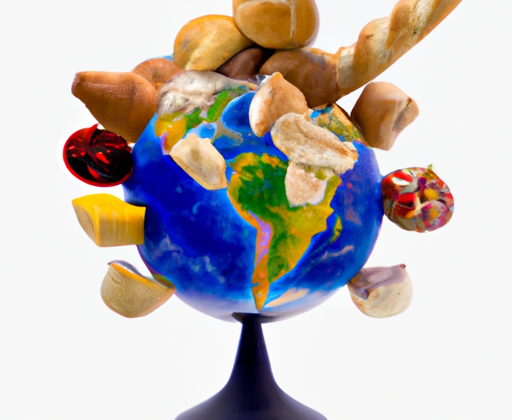Get Ready to Digest: Introduction to Food Regulations
Hi there, foodie friends! Let’s talk about food regulations – something that we all can’t run away from. Trust me; I have tried. Did you know that there are different types of food regulations? From regional regulations down to international ones, we’ve got it all. The main purpose of these regulations is to ensure that our food is safe to eat. But, before we delve into the nitty-gritty details, let me give you a brief overview of food regulations globally.
Food regulations are used all over the world to make sure that the food we eat is safe, healthy and of good quality. These regulations differ depending on where you are in the world. Some countries have strict regulations, while others are more relaxed. Some are even non-existent! So, if we want to maintain the quality and safety of our food, we need to have food regulations in place that are stringent and consistent.
Are you curious about what types of food regulations exist? Head on over to this page to learn more and to prepare for a food-secure future.
Get to Grips with the Different Forms of Food Regulations
So, before we start diving into the benefits and drawbacks of food regulations, it’s essential to understand the different types available to us, right? There are two main types of food regulations: regional and international rules that we can divide into different categories.
Regional Food Regulations
Individual countries or governing bodies set regional food regulations, which are unique to each area. This approach benefits countries because they get to govern themselves without external interference. It often leads countries to put into place rules that are specific to their cultural practices and dietary requirements. For example, in some countries, certain animal products are prohibited due to religious or ethical reasons.

As the name implies, these regulations are set at an international level by various organizations drawing up common rules. International food safety organizations dictate these rules to harmonize food production and consumption globally. The Codex Alimentarius Commission, an international food standards body created by the Food and Agriculture Organization of the United Nations (FAO), is one of the most prominent organizations that sets global standards.
Understanding the different types of regulations might seem insignificant, but if we know the differences in focus, we’re better equipped to critique them and come up with solutions that fit our particular circumstances.
The Pros and Cons of Food Regulations: What You Really Need to Know
Food regulations can have both benefits and drawbacks. On one hand, they ensure that the food we eat is safe and free from harmful contaminants. However, they can also be costly for food producers and may limit consumer choices. Here are some of the main benefits and drawbacks of food regulations:
The Benefits of Food Regulations
First and foremost, food regulations provide a level of safety and assurance for consumers. They ensure that food is prepared, stored, and transported in a way that is safe for human consumption. This can help to prevent foodborne illnesses and other health problems that may arise from contaminated food.
Food regulations can also help to protect the environment. By ensuring that food production practices are sustainable and environmentally friendly, regulations can reduce the negative impact that food production can have on the planet.
Finally, food regulations can help to promote transparency and trust in the food industry. By requiring food producers to label their products accurately and to be transparent about their production practices, consumers have more information about what they are eating and can make more informed choices about the food they buy.
The Drawbacks of Food Regulations
Some argue that food regulations can be too costly for small-scale food producers, making it difficult for them to compete with larger companies. Regulations can also limit consumer choice by imposing restrictions on certain types of food or ingredients.
Additionally, there is the risk of over-regulation, with regulations becoming too complex and burdensome to navigate. This can lead to decreased innovation and creativity in the food industry, with companies focusing more on complying with regulations than on developing new and exciting food products.
It’s also important to note that not all food regulations are created equal. Some regulations may be more effective than others, and there may be unintended consequences that arise from implementing certain types of regulations. As with any type of policy, it’s important to carefully consider the potential benefits and drawbacks before implementing food regulations.
4. Examples of Successful Food Regulations – Yum Yum Edition!
Okay, so I’m a foodie. I love trying different cuisines and exploring new tastes. And for me, one of the most important things about a dish or a meal is knowing that the food I’m eating is safe and healthy.
That’s why food regulations are so important. And thankfully, there are some great examples of successful food regulations that have made a real difference in the quality of our food.
Case Study 1: Japan
Japan is known for its strict food regulations, and for good reason. The country has one of the lowest rates of foodborne illness in the world, thanks in part to its rigorous food safety standards.
One of the most notable examples of Japan’s successful food regulations is its strict limits on pesticide residues. While some countries allow much higher levels of pesticides in their food, Japan has set some of the strictest limits in the world. And it’s working – the country has one of the lowest rates of pesticide-related illnesses in the world.
Case Study 2: Denmark
Denmark is another country that has taken food regulations seriously. One of its most successful initiatives has been its efforts to reduce trans fats in foods.
Trans fats are a type of fat that have been linked to an increased risk of heart disease, and many countries have taken steps to reduce or eliminate them from the food supply. In Denmark, the government worked with the food industry to gradually phase out trans fats in foods, and by 2003, the country had almost entirely eliminated them from its food supply.
As a food lover, I’m grateful for these successful food regulations. Knowing that I can enjoy a delicious meal without worrying about harmful pesticides or unhealthy fats gives me peace of mind, and it’s all thanks to the hard work and dedication of people who care about our food.
## Challenges Facing Food RegulationsAs someone who has worked in the food industry for many years, I have seen firsthand the challenges that food regulations face. Here are some of the biggest issues that we encounter:
First of all, there is a lack of standardization across countries when it comes to food regulations. What is considered safe or acceptable in one country may not be in another. This can lead to confusion for both consumers and producers, as they have to navigate different regulations depending on where they are located or where they are selling their products. It also makes it difficult for international trade, as regulations can act as barriers to entry.
Another issue is the difficulty in enforcement. Food regulations are only effective if they are enforced, and this can be a challenge. There are a lot of products on the market, and it can be difficult to keep up with them all. Additionally, not all producers are compliant with regulations, and it can be challenging to catch those who are not. This can put consumers at risk, as they may unknowingly consume unsafe products.
In general, food regulations are a necessary aspect of our food system. They help ensure that our food is safe and of high quality. However, the challenges they face are very real. As we move forward, it will be important to continue to assess and improve upon our current regulations to ensure that they are effective and sustainable.
Wrap-Up: Time to Digest Food Regulations?
Well, folks, that’s a wrap! We’ve covered quite a bit on food regulations around the world. As we mentioned earlier, it’s no secret that food regulations affect virtually all aspects of our food production and consumption. But what have we learned, you ask? Let’s take a closer look.In the beginning, we looked at the different types of food regulations, ranging from local (city-, county-, or state-level), to regional (i.e., European Union), to international (i.e., Codex Alimentarius Commission). Each level varies in terms of its scope of coverage, standards, and enforcement.Next, we delved into the benefits and drawbacks of food regulations. On one hand, food regulations provide protection to consumers’ health and safety, ensure fair competition, and support sustainable production and trade practices. On the other hand, food regulations can also be seen as a barrier to entry for small producers, creating unnecessary red tape and increasing production costs.We then analyzed two case studies on successful food regulations, such as Japan’s food labeling laws and the EU’s animal welfare regulations for poultry farming. These cases highlight how long-standing issues in the food industry can require concerted efforts from all stakeholders to bring about effective solutions.Of course, food regulations face many challenges, including the lack of standardization across countries and the difficulty of enforcement. It’s important to continuously evaluate the effectiveness of food regulations and make changes accordingly. So, are food regulations worth it? While the answer may not be entirely clear, it is safe to say that they play a vital role in shaping the food industry and ensuring consumer protection. Now, it’s time for us to digest the information we’ve covered and consider its implications for the future of food regulations.

